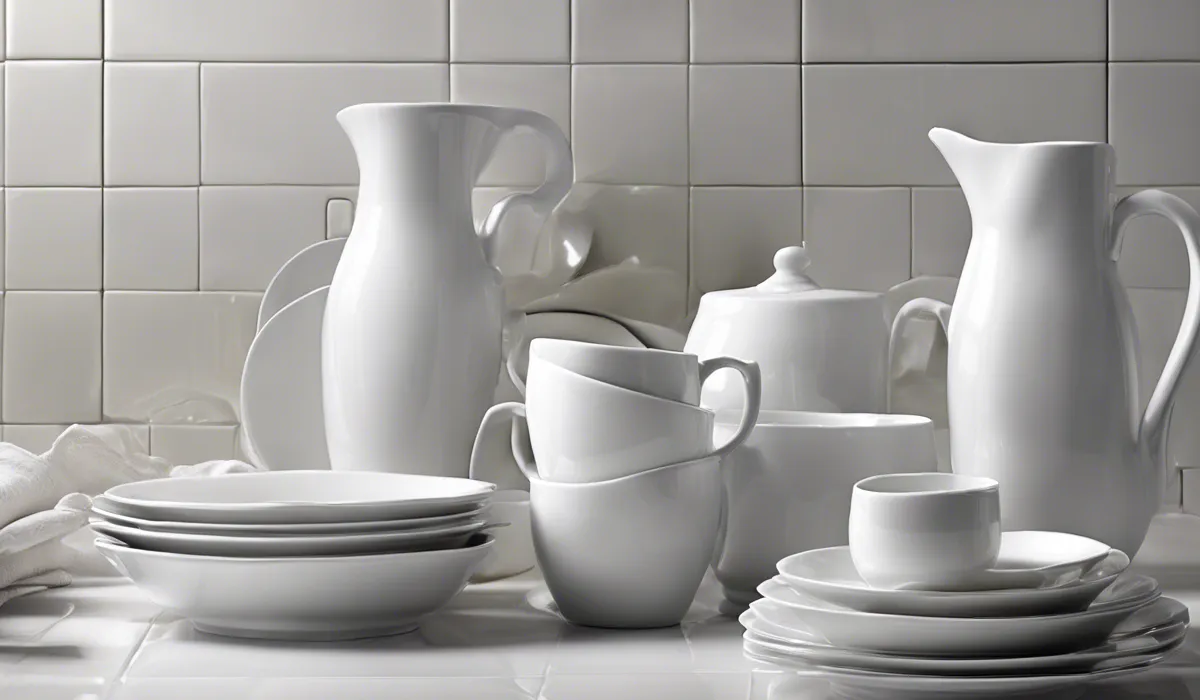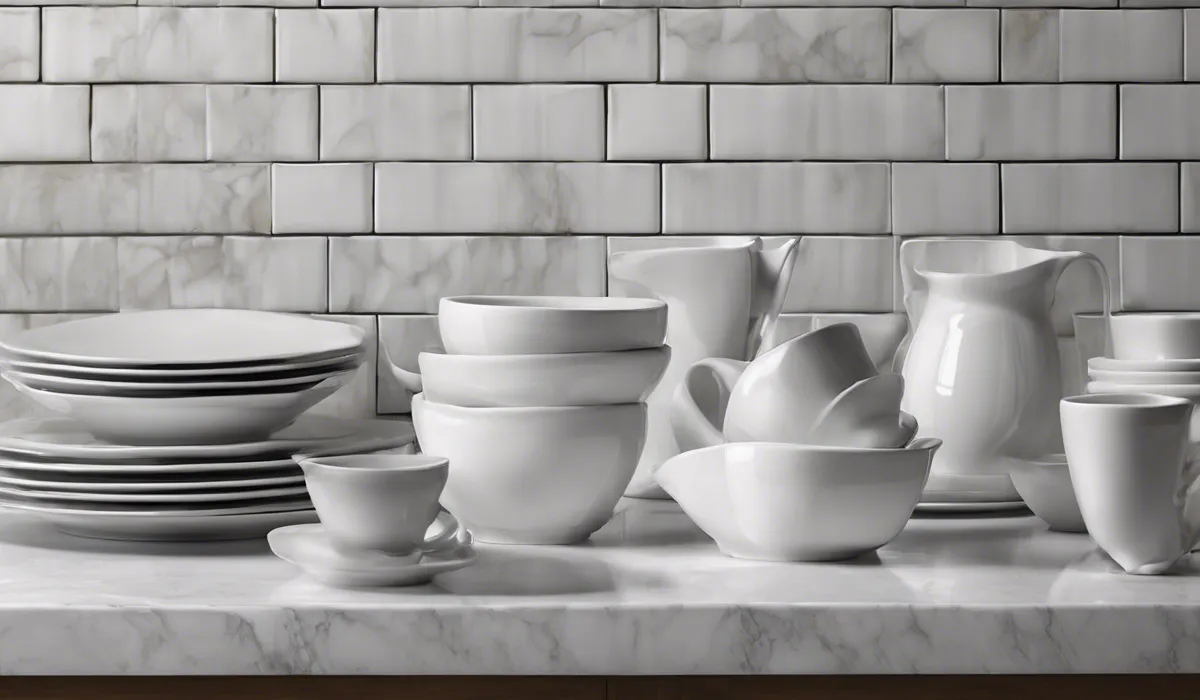Is Porcelain Dishwasher Safe? Debunking Myths & Tips
Most porcelain is dishwasher safe, but check for a manufacturer’s mark indicating this. Avoid high-temperature settings and abrasive detergents to prevent damage. Hand washing is recommended for porcelain with metallic accents or overglaze decorations.
Understanding Porcelain and Its Dishwasher Safety

Definition of Porcelain
Porcelain is a type of ceramic material known for its smooth surface and impressive durability.
It is made by heating refined clay at high temperatures, which gives it a translucent and delicate appearance. Yet, do not let its beauty fool you. Porcelain is strong and can handle everyday use very well.
Characteristics of Porcelain Dishes
Porcelain dishes come in all shapes and sizes, from plates and bowls to mugs and serving platters.
These dishes are not just pretty; they are also practical. They can often go from oven to table, making them a versatile choice for families and entertainers alike.
General Guidelines for Dishwashing Porcelain
Most porcelain is dishwasher safe, but you should always look for a manufacturer’s mark or sign that tells you this.
If you see that mark, you can feel confident putting your dishes in the dishwasher. Just remember to use care, as porcelain can still be delicate.
Factors that Determine Dishwasher Safety
Glaze Quality
The glaze on porcelain dishes protects them and makes them look good. High-quality glaze means your dishes are more likely to survive the dishwasher without chips or cracks.
Temperature Resistance
Porcelain can usually handle hot temperatures, but sudden changes from hot to cold can cause damage. Dishwashers can get very hot, so it is good to use a gentle or lower heat setting when cleaning porcelain.
Manufacturing Process
How porcelain is made can affect its safety in the dishwasher. Handmade or intricately designed pieces may need more care and might be better washed by hand to keep them looking their best.
Porcelain vs. Other Materials in the Dishwasher
Unlike plastic or metal, porcelain does not absorb food odors or flavors. It also does not rust. Because of this, porcelain is a great choice for dishwasher use, as it comes out clean and fresh every time.
Guidelines for Washing Porcelain in the Dishwasher

Preparing Porcelain for the Dishwasher
Removing Excess Food
Before placing your porcelain dishes in the dishwasher, scrape off any leftover food. This prevents food from sticking to the dishes during the wash cycle and helps keep your dishwasher clean.
Checking for Gold or Metallic Accents
If your porcelain has gold or metallic decorations, it is best to wash these pieces by hand. The dishwasher can cause these beautiful details to fade or even peel off.
Loading Porcelain Correctly in the Dishwasher
Positioning and Spacing
Load your porcelain carefully. Make sure each piece has enough room so they do not touch each other. This helps to avoid chips or cracks during the wash cycle.
Avoiding Contact with Other Materials
Keep porcelain away from pots, pans, and other heavy items in the dishwasher. These can knock against your dishes and cause damage.
Selecting the Right Dishwasher Settings
Temperature Considerations
Use a gentle cycle with a lower temperature setting for porcelain. This helps to keep your dishes safe from the high heat that can cause cracking or crazing (fine cracks in the glaze).
Cycle Length and Intensity
Shorter and more gentle cycles are best for porcelain. These cycles clean effectively without putting too much stress on your dishes.
Dishwasher Detergents and Porcelain
Recommended Types of Detergents
Use a mild detergent for porcelain dishes. These detergents clean well without being too harsh on the glaze or decorations.
Substances to Avoid
Avoid detergents with bleach or lemon additives. These can damage the glaze or cause the colors on your porcelain to fade over time.
Caring for Porcelain to Maintain Dishwasher Safety

Tips for Extending the Life of Porcelain Dishes
Handle your porcelain with care. Do not stack too many dishes on top of each other when storing them. Also, avoid sudden temperature changes that can shock the material.
Signs of Dishwasher Damage to Look Out For
After washing, check your porcelain for any chips, cracks, or crazing. If you notice these signs, you might want to wash that item by hand in the future to prevent further damage.
Hand-Washing vs. Dishwashing Porcelain Items
Hand-washing is the safest option for porcelain, especially for items with intricate designs or delicate features. It takes more time, but it keeps your dishes looking great for years to come.
Storing Porcelain Correctly to Prevent Damage
When storing your porcelain, place it in a cool, dry cabinet and use racks or liners to keep items from sliding. This prevents scratches and other damage.
When to Choose Not to Use the Dishwasher for Porcelain Items
For porcelain with metallic accents, hand-painted details, or if it is an antique or a piece of sentimental value, skip the dishwasher. These items are best preserved with gentle hand washing.
FAQs About Porcelain Dishwasher Safety
Is all porcelain safe to put in the dishwasher?
Most porcelain is dishwasher safe, but it is best to check for a manufacturer’s mark that specifically indicates this to be sure.
What should I avoid when washing porcelain in the dishwasher?
Avoid using high-temperature settings and abrasive detergents when washing porcelain in the dishwasher to prevent damage.
Can I put porcelain with metallic accents in the dishwasher?
Porcelain with metallic accents or overglaze decorations should be hand washed, as the dishwasher can damage these delicate features.
How can I ensure my porcelain does not get damaged in the dishwasher?
To prevent damage, use a gentle cycle, avoid high heat, and choose mild detergents when washing porcelain in the dishwasher.
What is the safest way to clean porcelain dishes?
The safest way to clean porcelain dishes, especially those with decorative elements, is by hand washing with a mild detergent and soft sponge.
Final Thoughts
Most porcelain can be washed in the dishwasher, but it’s essential to verify this with the manufacturer’s mark. To maintain its condition, opt for gentle cycles and avoid harsh detergents.
Porcelain pieces with metallic decorations or delicate overglaze should be carefully hand washed to preserve their beauty and integrity.





